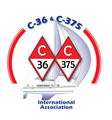I've become the lucky recipient of an ICOM M700 SSB HF transceiver with it's accompanying AT 120 HF Automatic Antenna Tuner from an old friend who left sailing some years ago and is now beginning to unload stuff he had on his last boat.. Has anyone installed this kind of HF communications equipment? Any thoughts on the antenna options? How's about the ground plate issue. (I'm just learning these terms.)
Tom Smith
Molly Malone, 1994 Catalina 36 Mod 1.5
Std rig, wing keel
—
Tom Smith
Molly Malone
1994 Mk 1.5
Std rig/wing keel

Although I have never done an HF installation - on a boat, that is...I have done quite a few airplanes in my early avionics career - I have given it some thought. My choice for antenna would be to insulate the backstay top and bottom (although I am not sure how to handle the split backstay...maybe insulate both splits???), and feed that insulated backstay portion from a lazarette-mounted coupler. HF antenna effectiveness depends greatly on having a good 'ground' for the signal 'to push off from.' Connecting the HF transceiver and coupler to a heavy copper ground plate fixed to the outside of the hull would be quite effective, especially in salt water.
As I consider the backstay, I think I would insulate the backstay near the masthead, then at the bottom of one of the splits; then the other split backstay I would insulate very near the backstay split junction, so as to take the other backstay out of the antenna equation entirely.
Larry Brandt
S/V High Flight #2109
Pacific Northwest, PDX-based
2002 C-36 mkII SR/FK M35B
I installed a used ICOM M700 a few years ago and had a rigger add a backstay antenna. The insulators are about 2 feet below the masthead and 1 foot above the split-backstay fitting. The cable is secured to the stbd split backstay and goes through a watertight port into the lazarette and to the tuner.
I cannot vouch for the 'best' ground plane' but I elected to run 50 feet of copper foil from the tuner to the maststep in the bilge, then back over to the portside, in a big V. I have never tried to transmit more than about 300 miles, but it worked fine.
Duane Ising - Past Commodore (2011-2012)
s/v Diva Di
1999 Catalina 36 Hull #1777
Std rig; wing keel, M35B, Delta (45#)
Punta Gorda, FL
http://www.sailblogs.com/member/diva-di/
[QUOTE=deising;8633]I installed a used ICOM M700 a few years ago and had a rigger add a backstay antenna. The insulators are about 2 feet below the masthead and 1 foot above the split-backstay fitting. The cable is secured to the stbd split backstay and goes through a watertight port into the lazarette and to the tuner.
I cannot vouch for the 'best' ground plane' but I elected to run 50 feet of copper foil from the tuner to the maststep in the bilge, then back over to the portside, in a big V. I have never tried to transmit more than about 300 miles, but it worked fine.[/QUOTE]
Thanks for the info. Where did you mount the tuner and transceiver?
Tom Smith
Molly Malone
1994 Mk 1.5
Std/wing
Tom Smith
Molly Malone
1994 Mk 1.5
Std rig/wing keel
I mounted the transceiver on top of the stbd shelf just aft of the game table. I made some brackets out of teak and the unit fit nicely. The run to the batteries under the aft game settee was very short that way, too.
As for the tuner, I elected to follow the lead of the HAM friend who sold me the unit. I bought a HAM tuner much cheaper than the marine units and mounted it right above the ICOM. The good news was that the tuner came with a harness and plug that was made for the ICOM M700, but it meant the run from the tuner to the lazarette and then up to the backstay antenna was fairly long. That is not supposed to be an ideal situation, but it does work fairly well.
I will try to post photos later tonight.
Duane Ising - Past Commodore (2011-2012)
s/v Diva Di
1999 Catalina 36 Hull #1777
Std rig; wing keel, M35B, Delta (45#)
Punta Gorda, FL
http://www.sailblogs.com/member/diva-di/